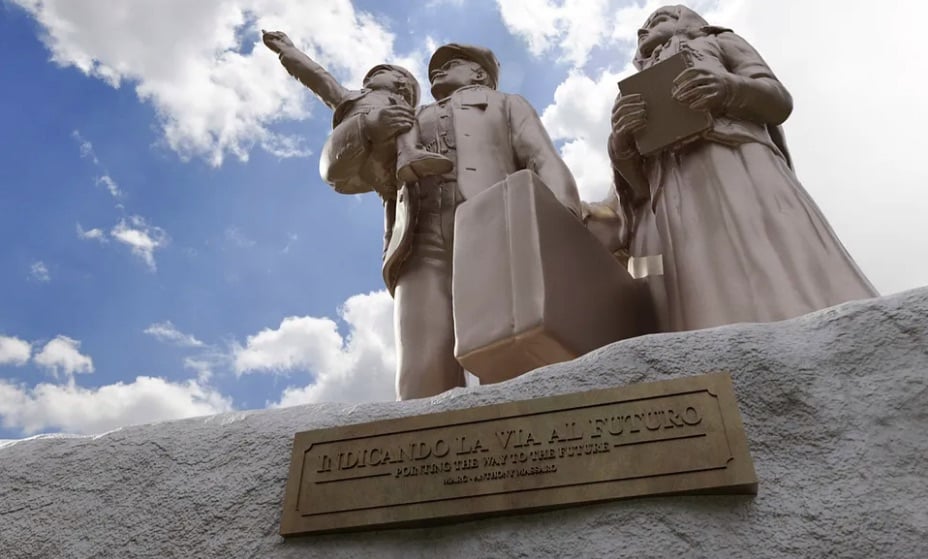
Public art | Arts & Culture | Visual Arts | Wooster Square | Sculpture | Elicker Administration
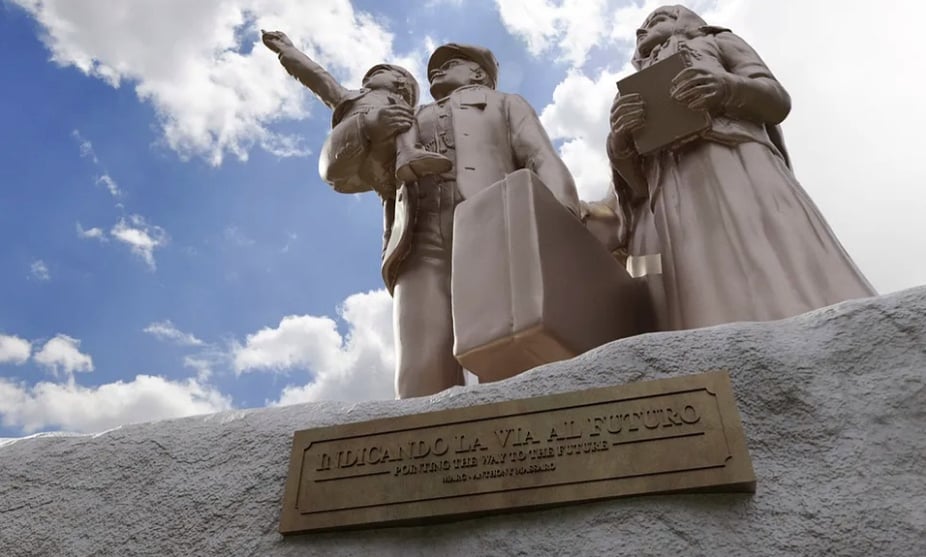
Rendering of Indicando la via al futuro (Pointing the Way to the Future) by Marc-Anthony Massaro.
An 1,800-pound, 10-foot, eye-level bronze rendering of an Italian immigrant family is one step closer to replacing a statue of Christopher Columbus in Wooster Square Park. Did city officials pressure their own commission to rush the process?
That question hung over a meeting of the New Haven Historic District Commission (HDC) Wednesday night, as city residents, officials, and commissioners debated a second, revised proposal from the Wooster Square Monument Committee (WSMC) for over three and a half hours. Following impassioned testimony, tears, allegations of anti-Italian racism, one call for the mayor to apologize, and one in-the-weeds skirmish over historic preservation, it passed five to one.
Commissioners Karen Jenkins, Tom Kimberly, Dylan Christopher, Doug Royalty, and Chair Trina Learned voted in support. Only Commissioner Susan Godshall, who objected strongly to lowering the 11-foot stone pedestal on which Columbus stood, voted in opposition. The proposal now continues on to the city’s Cultural Affairs Commission, New Haven Parks Commission, and the city’s full Board of Alders.
View the meeting minutes and recording, as well as the full proposal, at the commission’s website. The Wooster Square Monument Committee is a 26-member group assembled by Justin Elicker in July 2020 and led by Laura Luzzi and Bill Iovanne, Jr.. Read more about it here, here and here.
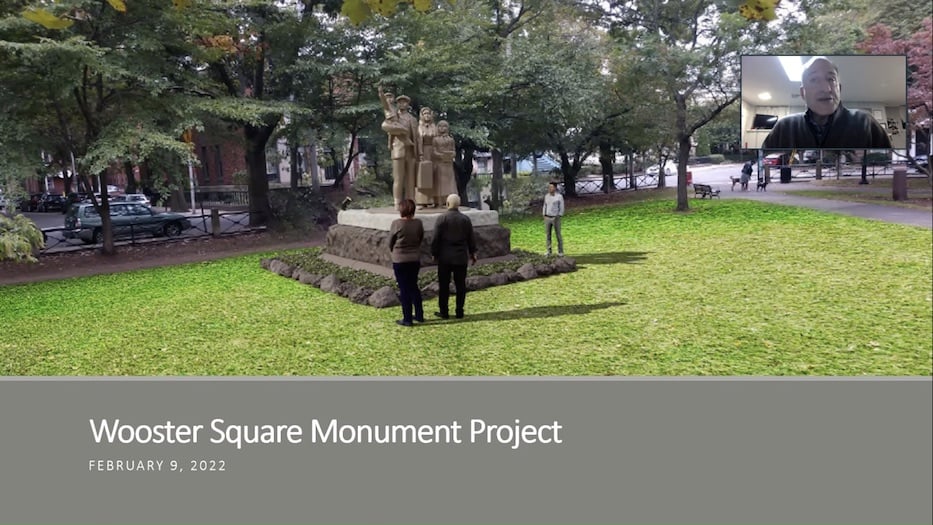
The revised application features Marc-Anthony Massaro’s Indicando la via al futuro (Pointing the Way to the Future) on a lowered, four-foot stone base, surrounded by landscaped elements, planters, and stones that have been removed from the original pedestal and repurposed. The black wrought iron fence that surrounded Columbus has been removed, and the sculpture is facing inward, toward Wooster Square Park.
It represents a significantly scaled-back version of an application that the committee brought unsuccessfully before the HDC in December; read more about that here and here.
By the end of the night, members of the WSMC left with the official certificate of appropriateness they had asked for. But at times, HDC Chair Trina Learned wondered aloud if commissioners were being pushed toward a premature vote by strongly-worded requests from Mayor Justin Elicker, WSMC member and Fair Haven Heights Alder Rosa Ferraro-Santana, and Deputy Chief Administrative Officer Rebecca Bombero.
“Typically things go through one or two commissions, but this has so many hurdles to jump over,” Elicker said close to the top of the meeting, with the tone of a parent about to scold a child in public. “And that work is important. The community process is important.
“But it also creates a lot of challenges for us reaching the finish line. Your review tonight, and favorable vote, is vital and will demonstrate that we’ve reached a consensus with the depiction of the family immigrating to the United States and finding a home in Wooster Square.”
“I Wish This Application Was Complete”
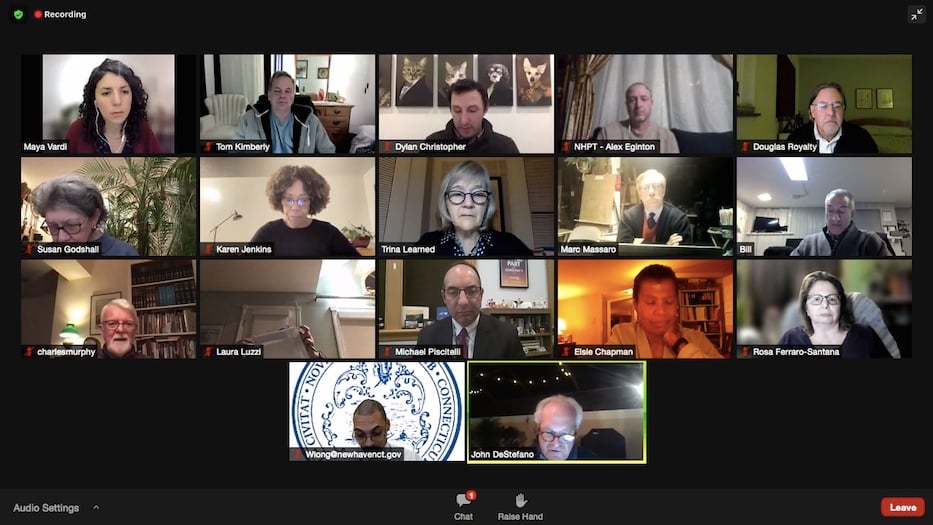
From the top of the meeting to a bleary-eyed vote close to 11 p.m., there wasn’t consensus. Commissioners arrived with concerns around the monument’s size, orientation, appropriateness of materials, potential for light pollution, and historic stone pedestal. Even the symbolic weight of the statue itself, which has been debated since June 2020, seemed up for discussion.
For over an hour, members of the committee, the city, neighbors, and the New Haven Preservation Trust spoke out both for and against the application, many maintaining that it was not yet ready for a final vote. For those who have been part of the process for over 18 months, testimony often became emotional and focused on both Columbus’s legacy and Massaro’s sculpture, in which they see themselves, their neighbors, and their families.
Many spoke directly to the history of Italians in New Haven, from East Rock/Cedar Hill Alder Anna Festa, who appeared on behalf of St. Michael’s Church, to former Mayor John DeStefano. Blazing through decades of history in just seconds, DeStefano praised Italians for their work to save the Wooster Square neighborhood from demolition during urban renewal, the scars of which still cross-cross the city.
“The time to do this is now,” he said, adding that he sees “the face of the Afghans that come to our city now” in the family Massaro has depicted. The artist’s design features a white Christian family of four, including a mother wearing crucifix jewelry.
As a member of the committee, U.S. Rep. Rosa DeLauro encouraged commissioners to vote in favor of the application, stressing the importance of putting the monument at eye level. In Massaro’s attention to detail—a flat coppola cap and neat mustache—she sees her Italian immigrant father and grandfather looking back at her. She noted that removing the fence and lowering the pedestal will give the sculpture a certain intimacy, turning it into an educational tool.
“It is something I think all immigrants can relate to and be proud of,” she said.
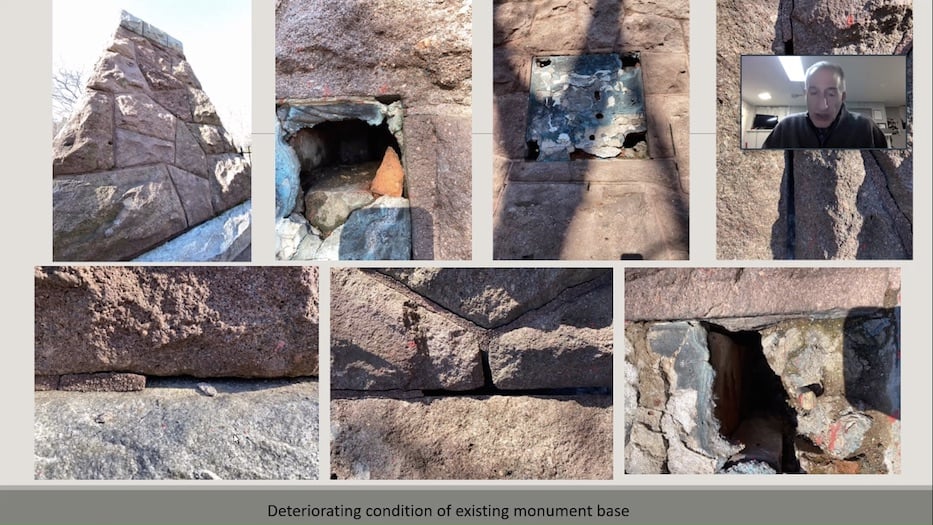
Others chimed in with substantial concerns around the design, from the size of title plaques to the potential use of cast aluminum instead of bronze (a potential cost-cutting measure, Iovanne told the HDC). While commissioners agreed unanimously that the fence can be removed—a relief to an artist who referred to it as prison-like in a meeting last month—they seemed less sure when it came to the original stone pedestal (more on that below), and the orientation of the sculpture itself.
Royalty wasn’t sure that the sculpture should face the park, he told the commission. When he imagines it facing inward, “the sculpture is turning its back on a public way,” he said. “I can't help wondering if it might be better oriented toward Russo Park, toward the public way.”
Godshall probed what a new monument might do to the structural integrity of what remains of the old one. She pointed to the possibility of freezing and thawing, which has left significant damage in the current structure. Learned pointed out that the dimensions of the plaques didn’t seem to be consistent. Both she and Godshall called for better measurements of the area, included on very few of the renderings.
Academy Street resident Alex Werrell, who spoke pointedly about the work at a Downtown-Wooster Square Community Management Team meeting in December, noted that this was precisely the reason for a lengthy approval process. He called on Elicker to apologize for what he saw as rushing the process.
“That sort of passive aggressive dismissal of those who are opposed to this statue proposal really shouldn’t have a place in our discourse,” he said. “I was embarrassed, frankly, to hear him talk about the committee hearing as some sort of road bump that is slowing down process on the installation of this monument. It’s not a road bump. It’s a destination in and of itself. It’s an essential part of the conversation.”
Exactly two and a half hours in, Learned reappeared to steer the committee’s discussion toward some sort of resolution. As she spoke, Massaro's team pulled up a rendering with an errant clip-art-esque plaque that began to move, resized by a pair of hands offscreen. She paused for just a moment, choosing her words carefully.
“I'm trying to overcome the commission's discomfort that we have incomplete information,” she said. “I wish this application was complete. I wish this application contained some very fundamental information—materials, what’s clearly in, what’s not, and dimensions. I heard very clearly both the mayor and the congressperson's urging to move this along, but the status of the application being incomplete is honestly not the commission's responsibility.”
What Is A Plinth, Anyway?
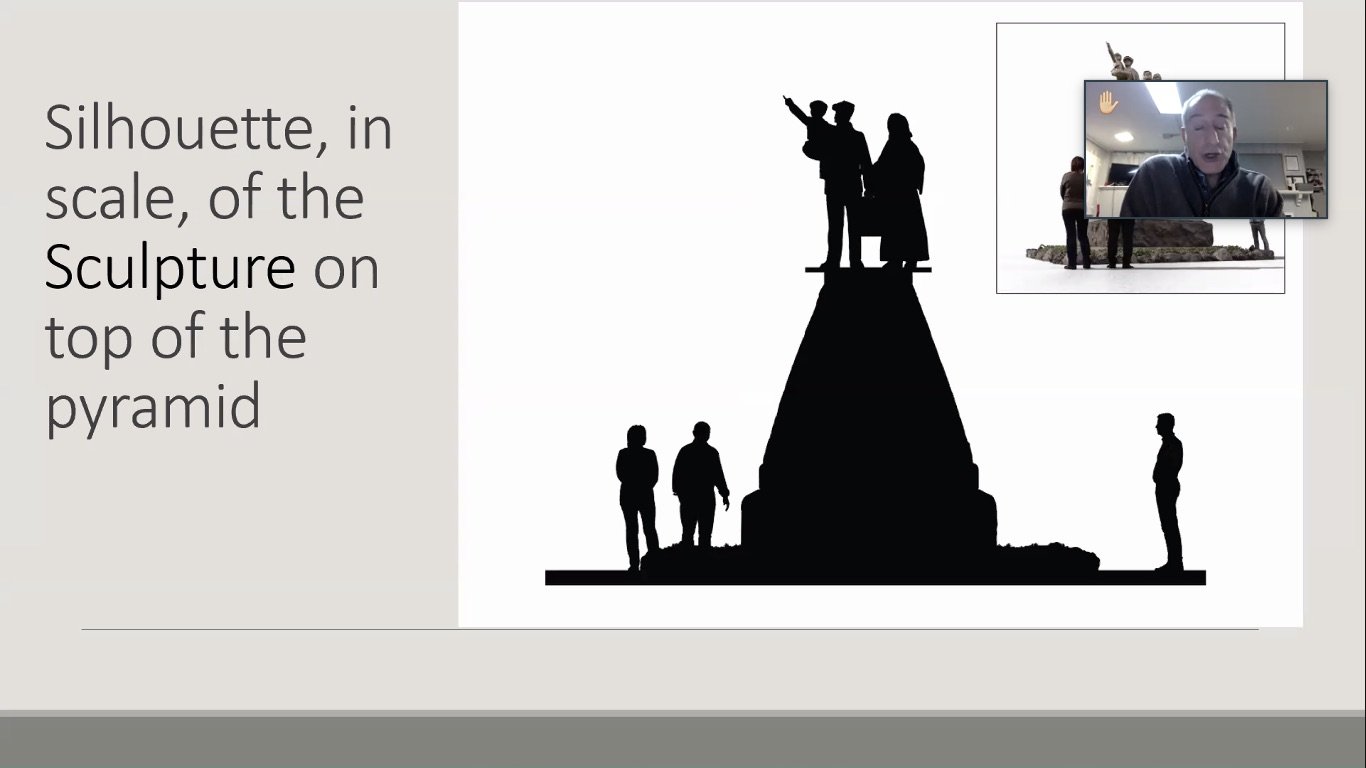
Maybe not a good idea? In response to Godshall’s early February request for a rendering with the full pedestal, Massaro pulled up a silhouetted image of an 1,800-pound hunk of bronze teetering precariously atop the existing stone pedestal.
The most time-consuming line of questioning came down to the pedestal—or plinth, pillar, or monument itself depending on who was speaking—on which Columbus stood until June 2020. The piece, which now stands quietly at one corner of the park, is the work of local nineteenth-century stonemasons.
The WSMC wants to lower the pedestal from its current height as a step towards adaptive reuse and accessibility. Multiple times throughout the evening, Iovanne stressed that Massaro would not be throwing any stones away, but incorporating them into the design. He looked to the relative accessibility of Dana King’s sculpture of William Lanson on the Farmington Canal Heritage Trail as a reference point.
On the other hand, hard line preservationists don’t want to see any portion of it dismantled. At her most passionate, Godshall hurled the words “rubble” and “undignified” across the Zoom screen with fiery flourishes and vocal crescendos. Royalty, who ultimately voted in favor of the application, suggested the proposal “cannibalized” the pedestal. Only Commissioner Karen Jenkins, who did not speak for the entire meeting, suggested that such language might seem a little incendiary.
At points, the debate veered towards theatrics. In response to Godshall’s early February request for a rendering with the full pedestal, Massaro pulled up a silhouetted image of an 1,800-pound hunk of bronze teetering precariously atop the existing stone plinth, which appeared ready to buckle beneath its weight. It looked as though he had pulled it from an illustrated Amelia Bedelia novel, or perhaps the artist Kara Walker’s worst nightmare.
“This basically defeats the intent the Wooster Square Monument Committee was looking to achieve with the monument,” Massaro said. “In my opinion … this is somewhat unstable, it’s unsafe, I don’t think it’s very visually appealing, and it completely misses the mark in accommodating the Wooster Square Monument Committee’s objectives and intent of what this monument was supposed to convey.”
Speaking early in the evening, New Haven Preservation Trust member Alex Eginton thanked the committee for taking the time to fold in feedback from both the December HDC meeting and the wider Downtown-Wooster Square community. But he suggested lowering the pedestal, which would include dismantling its upper pyramid, still defied preservation guidelines.
“The Trust feels that these guidelines may have been misinterpreted or are still need to be applied for appropriate treatment of the monument pillar,” he said. “The Trust strongly recommends that the full pillar of the monument be kept.”
Anstress Farwell, head of the New Haven Urban Design League, also spoke out in defense of the pedestal, and suggested that it might be moved to where Columbus is now hidden from public view. While there has been very little discussion of Columbus’ new home, several speakers throughout the evening mentioned the Knights of Columbus Museum as a suitable place for both the pedestal and the sculpture.
“It’s a very worthy and beautiful work of art, made by people who did not know the history of Columbus that we know today,” she said. “I think that really the entire plinth needs to go with it .. I do find it, in fact, a little disturbing, the idea of cutting up the base. I find it kind of atavistic, like a pile of bones.”
For Royalty, who clarified that he loves the original stonework and does not want to see it taken apart, the structure does not have the same significance without Columbus on it. For a moment, it seemed as though Learned were leading a philosophy class instead of a commission meeting.
”For me, it feels like a historic house that has been cut in half,” he said. “That's how I feel about the plinth. I don't think that it's a historic structure on its own. It’s a piece of the Columbus monument. I guess I would reluctantly vote for lowering the base because I don't think that it violates the standards to do that.”
“I fully understand the desire, maybe even the need, to lower the plinth,” he later added. “It’s almost intuitive to lower this sculpture that celebrates everyday heroes.”
“You were postulating that the monument alone was not a contributing structure,” Godshall retorted. “No one is leaving it alone! We're putting a statue on it.”
The discussion rolled on. Commissioner Tom Kimberly entertained disassembling and numbering parts of the pedestal, which would then travel around with the Columbus statue. Somehow, LED lights made their way back in for one last concern.
And then, when it seemed not resolved at all, Learned came back into the discussion. Noting the hour and that “I'm still wrestling with the actual application,” she moved to make a motion to vote—on the condition that the committee provide more detailed designs “before the commission is fulfilled,” meaning before building begins.
Iovanne watched as the application passed. “We thank you very much for your time and your efforts,” he said.

